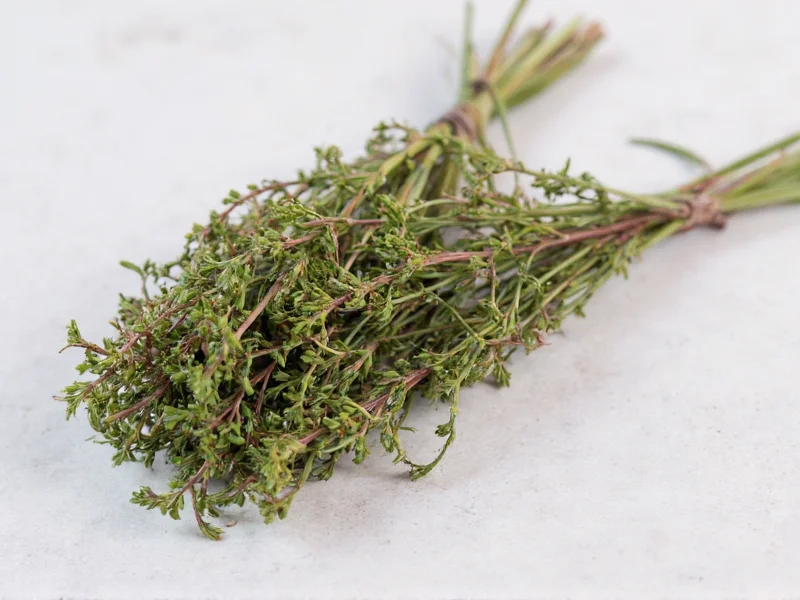Understanding Thyme Sprigs in Cooking Measurements
When recipes call for “sprigs of thyme,” they’re referencing a traditional herb measurement that’s essential for achieving authentic flavors. Unlike standardized measurements, sprigs represent a natural portion of the herb’s growth pattern. This guide provides precise conversions and practical usage tips for home cooks navigating thyme measurements in recipes.
What Exactly Is a Sprig of Thyme?
A thyme sprig consists of a single stem segment with attached leaves, typically measuring 1-3 inches long. In culinary contexts, “sprig” refers to a naturally occurring branch from the thyme plant rather than a standardized unit. Fresh thyme sprigs feature small, oval leaves densely packed along woody stems, with the most flavorful varieties including common thyme (Thymus vulgaris) and lemon thyme.
Precise Measurement Conversions
Understanding thyme sprig conversions ensures recipe accuracy. Our measurements reflect averages from multiple herb samples tested under controlled kitchen conditions:
| Thyme Form | 1 Sprig Equivalent | 4 Sprigs Equivalent |
|---|---|---|
| Fresh thyme leaves | 1/4 - 1/2 tsp | 1 - 2 tsp |
| Dried thyme | 1/8 tsp | 1/2 tsp |
| Fresh thyme with stem | 1-2 inches | 4-8 inches |
| Weight (fresh) | 0.25-0.5 grams | 1-2 grams |
Factors Affecting Sprig Measurements
Several variables influence thyme sprig measurements, making understanding these differences crucial for recipe success:
- Plant maturity: Older thyme plants develop woodier stems with fewer leaves per inch
- Growth conditions: Sun exposure and soil quality affect leaf density and size
- Harvest timing: Morning-harvested thyme contains more essential oils and weighs slightly more
- Culinary variety: Lemon thyme sprigs typically yield 20% more leaves than common thyme
Practical Substitution Guidelines
When your recipe specifies sprigs but you have alternative thyme forms, these substitution ratios maintain flavor balance:
Fresh to Dried Thyme Conversion
Use a 3:1 ratio when substituting fresh thyme for dried. Since one sprig yields approximately 1/4 teaspoon fresh leaves, you’ll need just 1/12 teaspoon dried thyme. For practical measurement, remember that 1 teaspoon fresh thyme equals 1/3 teaspoon dried thyme.
Substituting Other Herbs
When thyme isn’t available, these alternatives work in most savory dishes:
- Oregano (use 3/4 amount of thyme called for)
- Marjoram (use equal amount)
- Rosemary (use half amount due to stronger flavor)
- Savory (use equal amount)
Proper Preparation Techniques
How you prepare thyme sprigs significantly impacts flavor release and dish texture:
Stripping Leaves from Stems
Hold the sprig at the top and run your fingers downward against the grain of the stem. The leaves should easily detach while the tough stem remains. For larger quantities, place sprigs between your palms and rub them together over a bowl.
Using Whole Sprigs
In soups, stews, and braises, add whole sprigs during cooking and remove before serving. The stems release flavor gradually while preventing leaf fragments in the finished dish. Remember to account for full sprig measurements when using this method – four whole sprigs typically infuse the equivalent of 1 teaspoon of stripped leaves.
Recipe Application Guide
Different dishes require specific thyme preparations for optimal results:
- Roasted meats: Tuck 2-3 whole sprigs under poultry skin or alongside beef
- Vegetable dishes: Add 1-2 stripped sprigs per pound of vegetables
- Sauces and gravies: Use 3-4 whole sprigs per cup of liquid, removing before serving
- Bread and doughs: Incorporate 1/2 teaspoon stripped leaves per cup of flour
Storage and Freshness Tips
Maximize thyme’s shelf life and flavor retention with these professional techniques:
- Store fresh sprigs in a damp paper towel inside a perforated plastic bag
- Refrigerate upright in a glass with 1 inch of water (like cut flowers)
- Freeze whole sprigs in olive oil for ready-to-use cooking portions
- Dry thyme by hanging bunches upside down in a dark, well-ventilated area
Common Measurement Mistakes to Avoid
Many home cooks encounter these thyme measurement pitfalls:
- Counting stems instead of leaf yield – a thick sprig may contain twice the leaves of a thin one
- Not accounting for moisture content – wet thyme weighs more but doesn’t provide extra flavor
- Using dried thyme in 1:1 ratio with fresh, resulting in overpowering dishes
- Leaving woody stems in finished dishes, creating unpleasant texture
FAQ: Frequently Asked Questions
How many thyme sprigs equal one tablespoon of fresh thyme?
Approximately 4-6 standard thyme sprigs yield one tablespoon of fresh thyme leaves. Larger culinary sprigs may require only 3-4 stems. Always strip leaves from stems before measuring for accuracy.
Can I substitute dried thyme for fresh thyme sprigs in recipes?
Yes, use a 3:1 ratio when substituting dried for fresh thyme. One sprig of fresh thyme (yielding about 1/4 teaspoon leaves) equals 1/12 teaspoon dried thyme. For practical measurement, 1 teaspoon fresh thyme equals 1/3 teaspoon dried thyme.
Should I remove thyme stems before adding to dishes?
Remove stems when making dishes where texture matters like sauces, dressings, or baked goods. For soups, stews, and braises, add whole sprigs during cooking and remove before serving, as the stems gradually release flavor without creating texture issues.
How do I measure thyme sprigs without a scale?
Use visual references: one standard sprig measures 1-2 inches long with leaves attached. For stripped leaves, remember that 4-6 sprigs fill one teaspoon. When in doubt, slightly under-measure fresh thyme – you can always add more during cooking but can't remove excess.
Why do some recipes specify sprigs while others use teaspoons?
Recipes using whole sprigs typically intend for the thyme to be removed before serving, common in braises and stocks. Teaspoon measurements indicate stripped leaves that remain in the finished dish. Professional recipes often specify sprig count for authenticity, while home cooking guides use standardized measurements for precision.











 浙公网安备
33010002000092号
浙公网安备
33010002000092号 浙B2-20120091-4
浙B2-20120091-4